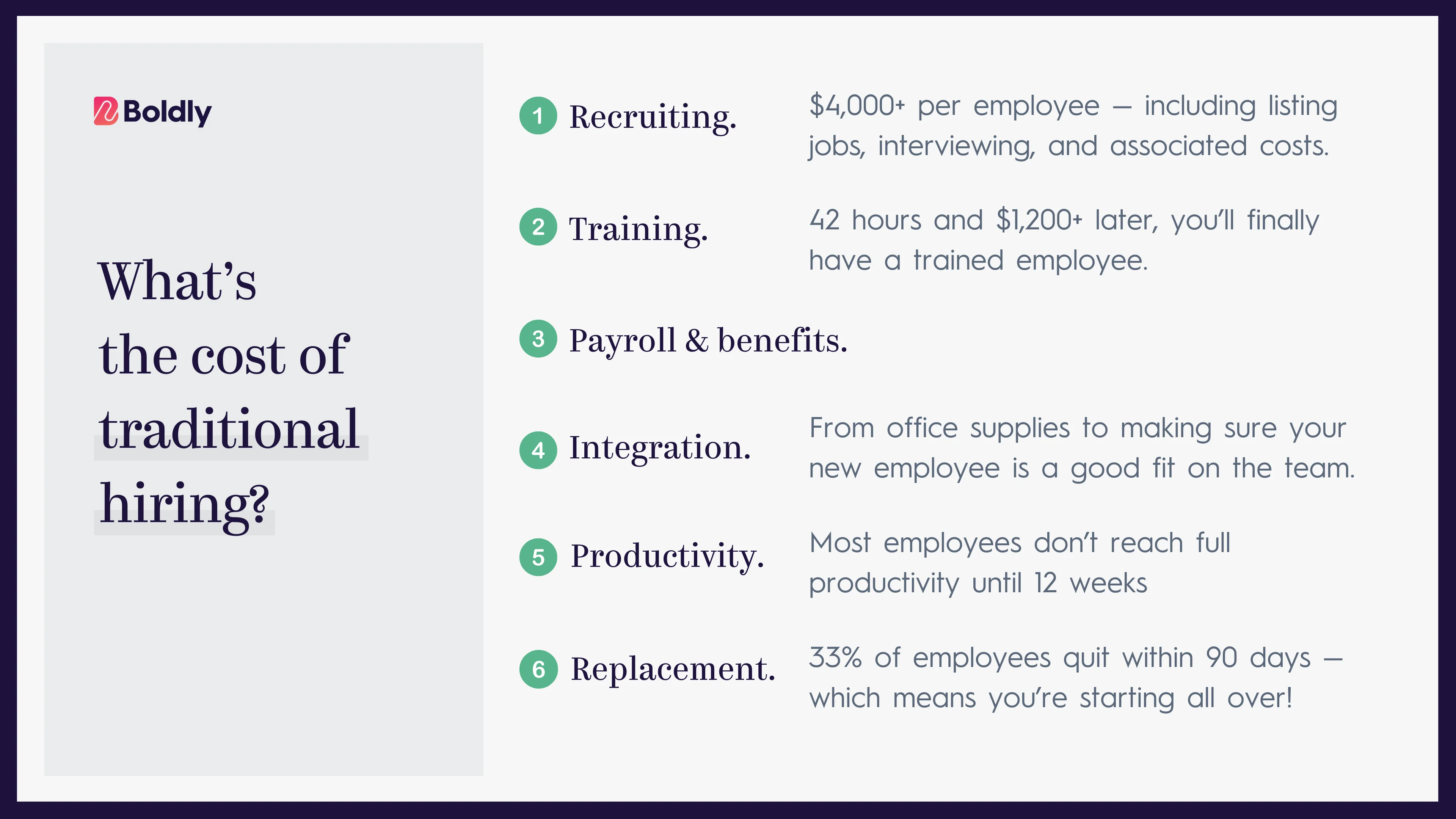When you’re a CEO in the tech industry, it feels like time and the speed of light are synonymous.
Each day is about change. The tempo for making decisions is fast. Volatility is standard operating procedure. As the leader, it has to all come together on a path towards growth.
Keeping that growth on track requires hiring, which requires time.
That’s where things get tricky.
A CEO’s Most Valuable Resource
As a tech CEO, your most valuable resource is time.
This is why a CEO’s personal assistant is invaluable. A highly skilled executive assistant is a force multiplier, handling everything from scheduling and communication to complicated project management. Top tech CEOs often credit much of their success to exceptional executive assistants who keep their professional lives running smoothly.
But finding the right person when you need to hire an executive assistant is tough. The longer you wait to fill the gap, the slower you move.
From this perspective, traditional hiring creates new problems even as it solves others.
How Traditional Hiring Slows You Down
Time is money, but money is also money. The hiring process eats up both.


The traditional hiring process, where you recruit, interview, and onboard a new employee, works poorly for a tech CEO. It’s a process that seems to have built-in stop signs and there are multiple costs you have to consider when hiring.
- The cost of recruiting. This includes time listing jobs, interviewing, and associated costs. It can total nearly $4,000 per employee. For high-level positions like a tech company CEO’s executive assistant, this cost can be significantly higher due to the specialized skills required.
- The cost of training. 42 hours and $1,200+ later, you’ll have a trained employee. But you have to spend that time and money to get your employee up to speed.
- The cost of payroll (and benefits). This cost varies, based on salary and additional benefits. The overall cost of an employee, with taxes, benefits, and legal considerations included, is staggering. Someone who is paid a salary of just $35K might cost you closer to $50K. When it comes to the salary of CEO assistants, the cost is often more substantial, reaching six figures for top-tier talent.
- The cost of integration. These costs include everything from the desk chair to making sure your new employee is a good fit on the team. Hiring someone who will work well with your team’s culture is tough; the interview process doesn’t really reveal true personality and work styles.
- The cost of productivity. New employees take time to ramp up to full productivity. Most employees don’t reach full productivity until 12 weeks. Until that point, you’re paying full salary for partial productivity.
- The cost of replacement. 33% of employees quit within 90 days. That’s shortly after they finally reach full productivity! It also means you have to start the hiring process all over again each time it happens.
If you need to hire someone right now to keep your company on a growth track, you don’t have a lot of options. But when you consider the time and cost, and how much is riding on making sure you get the right someone, it feels more like a gamble than mere standard business procedure.
They might stick around. They might fit in with your team. They might have the skills you need.
Or they might not.
Traditional hiring takes way too much time. It costs too much money. And the results aren’t always predictable or satisfying.
The Critical Role Of Executive Assistants In Tech
In the fast-paced world of technology, the tech CEO’s executive assistant plays a crucial role in maintaining productivity and efficiency.
These professionals are often the unsung heroes behind successful tech leaders, managing complex schedules, facilitating communication, and even contributing to strategic decisions. However, the process to find tech CEO EA candidates who can truly excel in this demanding role is often time-consuming and challenging.
This is where innovative hiring solutions become essential for tech companies looking to maintain their competitive edge.
The Perfect Hiring Process For Tech CEOs
The hiring process seems bleak for tech CEOs in a time crunch. If you could make a wish list for bringing on new, much-needed talent, what would it look like?
Speed would be an obvious start.
Tech companies move fast. You’re dealing with constant iteration in product, design, and competitive landscape at not only a daily level, but almost an hourly level. When you need people on your team, you need them yesterday.
The ability to quickly hire executive assistant talent can make a significant difference in maintaining momentum and staying ahead of the competition. If you could skip the recruitment, interviewing, and training part of hiring and get right to top productivity, that would help you out a lot.
Having more control over the financial cost would be next.
Shave off some time as described above, and you’re automatically saving money. But wouldn’t it be nice if you could cut the hard costs, too? That would mean finding a way to save on recruitment, salary, benefits, and replacement.
And then there’s the issue of how long it takes a new hire to onboard and become fully productive. Paying for less than top work hurts, which is seen in how skilled and experienced the new hire is, and if they’re able to gear up quickly and learn as they go.
With this wishlist in mind, you have a few options:
- Temp agencies – They’ll help you fill a spot right now, but they are temporary. Unless you hire them on after testing if they are a good fit, you’re caught in a permanent replacement cycle. And it’s not a solution that resolves the issue of time and costs of onboarding, team integration, and the payroll costs of an employee.
- Independent contractors – These can plug a hole when you need help, and they might seem a bit more budget-friendly because they aren’t on payroll, but there is still a recruitment issue. You have to find talented freelancers and independent contractors who have the skills you need. Plus, you have to be very careful that you’re in compliance with the laws surrounding independent contractors.
- Virtual assistant services – Can provide you with highly capable team members and the flexibility of bringing someone onto your team without geographical constraints, but these services are not all alike. Some might have a pool of workers and simply assign you whoever is next in the pool, whether permanently or on a project-by-project basis. That means you’re not necessarily matched with someone who’s a good fit for how you work.
Some virtual assistant services provide you with independent contractors, which means you still have the compliance issues to worry about.
Others might provide you with someone you can hire as an employee, but that means you have to be in compliance with employee laws wherever the virtual assistant is located.
And at the end of the day, you’ll still have the payroll expenses to deal with!
Subscription Staffing Meets Every Hiring Challenge
At Boldly, we take a different approach to virtual staffing with three crucial differences from other companies:
- Only the best. We find Fortune 500-trained executive assistants with 10-15 years experience, meaning we sift through thousands of applicants making sure we only hire those who are exceptionally talented, most with C-suite experience.
- Our employees. We hire them as our W2 employees and part of the Boldly culture. We take care of all the compliance issues and payroll costs. They’re our team assigned to support you for the long term in a way that allows you to integrate them as though they were your employee.
- Your preferences. We listen to what you want in skill, experience, and personality and we connect you with a well-matched team member. Finding a team member who’s a good match is very important, and we know we’re getting it right because some of our client-team pairings have lasted more than seven years… and counting!
But we’re not done.
We have an additional way to get your bottom line under control, bring on new team members quickly, and have confidence in having a flexible team.
It starts with a subscription.
The Subscription Staffing Advantage for Tech CEOs
Tech companies helped bring in the subscription economy.
It makes sense to turn to subscription staffing as a hiring solution, only paying for what you need through a subscription fee instead of payroll.
For tech leaders looking to hire executive assistant talent without the traditional hassles, subscription staffing offers a compelling solution. This innovative approach allows top tech CEOs to access highly qualified assistants quickly and efficiently.
By leveraging a subscription model, you can:
- Reduce time-to-hire dramatically
- Scale support up or down based on your needs
- Avoid the complexities of traditional employment
- Access a pool of pre-vetted, highly skilled professionals
This flexibility is particularly valuable in the tech industry, where agility and rapid adaptation are key to success.
Instead of wasting time when you need help now, you simply contact us and solve your hiring problem in days instead of months.
Yes, it really is that easy.
We’d love to talk to you today so you don’t lose momentum simply because you need to grow your team now!




